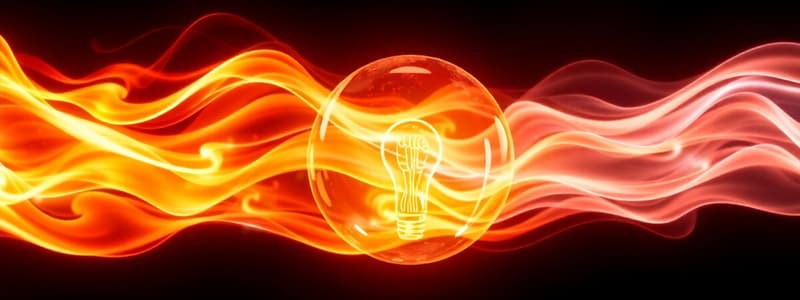Podcast
Questions and Answers
Which of the following best describes energy?
Which of the following best describes energy?
- The temperature of an object.
- The ability to do work. (correct)
- The amount of matter in an object.
- The speed of an object.
Potential energy is stored energy, while kinetic energy is the energy of motion.
Potential energy is stored energy, while kinetic energy is the energy of motion.
True (A)
What two factors determine the thermal energy of a substance?
What two factors determine the thermal energy of a substance?
temperature and mass
A _________ is an instrument used to measure temperature.
A _________ is an instrument used to measure temperature.
Match the following energy types to their descriptions.
Match the following energy types to their descriptions.
What happens to the particles in a substance as its temperature increases?
What happens to the particles in a substance as its temperature increases?
Temperature and thermal energy are the same thing.
Temperature and thermal energy are the same thing.
On which temperature scale does water freeze at 0 degrees?
On which temperature scale does water freeze at 0 degrees?
________ energy is the energy that an object has because of its motion.
________ energy is the energy that an object has because of its motion.
Which of the following is an example of energy conversion?
Which of the following is an example of energy conversion?
On the Fahrenheit scale, water boils at 100°F.
On the Fahrenheit scale, water boils at 100°F.
What is absolute zero in degrees Celsius?
What is absolute zero in degrees Celsius?
The Kelvin scale is based on the movement of _________.
The Kelvin scale is based on the movement of _________.
Match the temperature scales to their respective properties related to water.
Match the temperature scales to their respective properties related to water.
Which scientist developed the Kelvin scale?
Which scientist developed the Kelvin scale?
Flashcards
Energy
Energy
The ability to do work, existing in forms like light, sound, electricity, mechanical, thermal, and chemical.
Potential Energy
Potential Energy
Stored energy that an object or substance has due to its position or condition.
Kinetic Energy
Kinetic Energy
The energy that an object or substance possesses because of its motion.
Thermal Energy
Thermal Energy
Signup and view all the flashcards
Temperature
Temperature
Signup and view all the flashcards
Thermometer
Thermometer
Signup and view all the flashcards
Fahrenheit Scale
Fahrenheit Scale
Signup and view all the flashcards
Celsius Scale
Celsius Scale
Signup and view all the flashcards
Kelvin Scale
Kelvin Scale
Signup and view all the flashcards
Absolute Zero
Absolute Zero
Signup and view all the flashcards
Study Notes
- Energy is the ability to do work and exists in forms like light, sound, electricity, mechanical, thermal, and chemical energy.
- Energy can be converted from one form to another, as seen in a flashlight, where chemical energy becomes electrical and then light energy.
- Potential energy is stored energy due to an object's position or condition, like a roller coaster at the top of a track.
- Kinetic energy is the energy of motion, such as a flying jet or flowing water.
- People use matter and energy to meet their needs, either by changing energy forms or using matter to produce energy.
Thermal Energy
- Thermal energy is the total kinetic energy of the particles within a substance.
- A substance's thermal energy depends on its temperature and mass.
- Higher temperature means faster particle movement and more thermal energy.
- At the same temperature, a substance with greater mass has more thermal energy because it has more moving particles.
Temperature
- Temperature is the measure of the average kinetic energy of the particles in a substance.
- Temperature differs from thermal energy; a substance can have a lot of thermal energy but a low temperature if its particles move slowly on average.
- A thermometer is an instrument used to accurately measure temperature, using units of degrees.
- Temperature is commonly measured in degrees Fahrenheit (°F) or degrees Celsius (°C).
- On the Fahrenheit scale, water freezes at 32°F and boils at 212°F.
- On the Celsius scale, water freezes at 0°C and boils at 100°C.
Kelvin Scale
- The Kelvin scale, developed by William Thomson (Lord Kelvin), is based on molecular movement.
- The Kelvin scale uses kelvins (K) instead of degrees, with zero (0 K) representing absolute zero, where molecules theoretically stop moving.
- Absolute zero (0 K) is approximately equal to -273°C.
- Lord Kelvin's inventions were crucial for laying the first transatlantic telegraph cable.
Studying That Suits You
Use AI to generate personalized quizzes and flashcards to suit your learning preferences.




